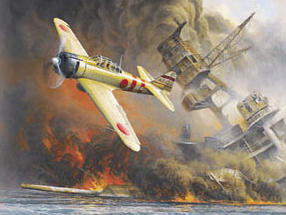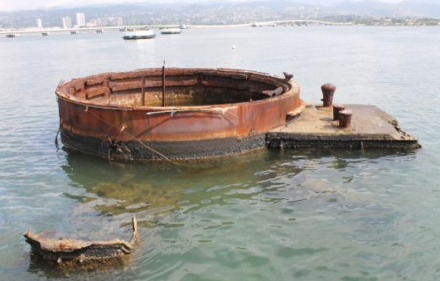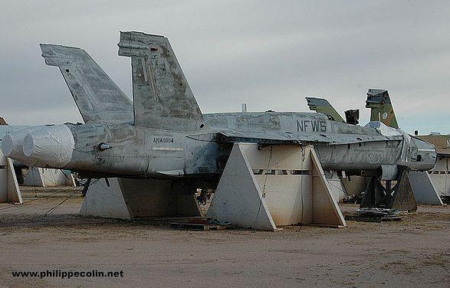Air Raid Pearl

(“Ground Zero,” a print by artist Don Kloetzke).
It is seventy-six years and a world away now, the great surprise.
I used to think about it a lot when we were young sailors in the Great Patriotic War against the Commies. In that year we were assigned to the staff of the Theater Anti-submarine Warfare Commander, a three star Admiral named Don Jones who also commanded the THIRD Fleet. We worked in a vault in a white headquarters building on Ford Island, in Pearl Harbor, Hawaii.
Ford Island was a tranquil spot in those days, accessible only by a slow harbor ferry from the mainland of O’ahu. The air was always redolent with the scent of the plumaria, and there was a mango tree in our yard in the Navy housing cantonment at McGrew Point. When we were not working, life was sweet.
Times being what they were, the staff worked around the clock, since the Pacific Ocean is a big place. Sometimes, going in on a Sunday to stand watch, I would be inclined to complain that the war could wait until Monday. Then the ferry would slide silently past the graceful white arch of the memorial, and the thick wide oil-can of the number three turret that projected from the placid waters of the harbor.

”Air Raid Pearl!” was the frantic call on the radio. It was a Sunday morning when the sailors of the USS Arizona woke to alarm bells, roaring engines, explosion, panic, and death.
Over 1,300 of her sailors and her Admiral are still there within her silent bulkheads. There is a persistent sheen of diesel fuel-marine spreading from the memorial. She bled then, and still bleeds, since when she died she was topped off for action, but there was not much happening at 0700 on that morning, except preparations for holy services under the awning rigged on the afterdeck.
Seeing her every day, I am always drawn to the notion of Intelligence shortfalls and inadequacies. We have beat the Pearl Harbor surprise to death. There certainly was evidence that something was going to happen. MacArthur said in an interview long ago that he was comfortable with the warning he had received from Washington; he just thought the attack was going to happen closer to his headquarters in Manila.
The list of missed clues is long. Matson Liner Lurline reported some unusual manual Morse traffic while inbound to Aloha Tower. Perhaps the code-breakers could have been more aggressive in decrypting the diplomatic traffic, though in their defense, the fruit of their labor was so highly valued and so vulnerable to loss that the transcripts were restricted to only the most senior members of the government.
The famous “East Wind Rain” intercept only informed the Japanese Legation of the fact of the attack. But we had warning, even Admiral Stark in Washington thought that the President should know first, and the President was indisposed. When the warning went to Pearl, it arrived as a telegram, after the attack had begun and the Arizona sailors were already dead.
The system was not rigged to provide alertment to decision making. The intelligence support to the National Command Authority of the day was fractured, the Army and Navy alternating support to Mr. Roosevelt in a rotation of intractable service jealousy. Within the Navy was the struggle about the very role of intelligence itself, and whether it should be an independent arbiter or just another tool in the operational tool-belt.
Even if you discount the tantalizing bits of information that could have been integrated to reveal the Japanese plan, including requests for the precise location of the American ships to the Japanese Consulate in Honolulu, the system knew that an attack was inevitable. But the intelligence assessment was accepted in the context of the policy. Policy assumed that action would start in the Far East, and that supporting action could be carried out by saboteurs in the Hawaiian Islands.
Better Human Intelligence would have helped. Navy was uncharacteristically good on that score, sending a handful of gifted young officers to learn a bit of the Japanese language and culture in the 1930s. But Japan was the hard target of the day, a tough one that would have required resources and determination to penetrate. It also would have needed spies who did not look as though they were from the Princeton Class of 1930.
The Japanese did the same thing. A young Lieutenant Isoruku Yamamoto, IJN, studied in the US, and he knew better than the warlords that it was lunacy to sneak-attack the Americans. The Westerners had a prodigious industrial machine, coupled with a righteous streak that would make the war a disaster for Japan. But he was a good officer, and he did what he was told, and he planned well, even if was a brilliant stroke on the road to Hell. Yamamoto commanded the Combined Fleet through the first sixteen months of triumph.
It was a measure of his worth that the most precious intelligence- a decrypt of his itinerary- was used to conduct a tactical intercept to shoot down his airplane. If the Japanese had realized how the Americans came to know his whereabouts, they might have changed their codes and the source would be lost. But they didn’t.
One of the reasons the attack on Pearl was a secret was that there were no spies in Tokyo to provide a clue to intent. All Washington had had was a glimmer of capability, and they had much of that wrong as well. The Japanese aircraft were nimble and maneuverable and the torpedoes worked well at much longer ranges than we thought. Accordingly, the aircraft were parked close together at Hickham Field, to make the defensive perimeter smaller. And it was the Army that was responsible for force protection in the islands, after all, and they were only in the process of acquiring long-range aircraft to patrol the sea frontiers, if the Navy was prepared to share the duty, that is.
Policy said we were going to war. We were already flying surveillance missions in support of the Royal Navy in the Atlantic. The Lend-Lease effort had been a great controversy, and Mr. Roosevelt had to deal with the new Know-Nothings like Lone Eagle Lindbergh, who thought the Germans had a point.
Pearl Harbor solved that problem for the policy. I like the old joke that went “in order to confuse Tojo, our first response to the debacle of Pearl Harbor was to land troops in North Africa.”
But it is completely appropriate that it is on the anniversary of that day that We appear to be sleep-walking into another surprise, as profound as that long-ago air raid. We are going to have to shut down the Government if the Congress cannot figure out some alternative of authorizing and appropriating cash. Of course,we only go through the motions of funding the President’s Budget; we have lived with endless number of Continuing Resolutions (with special rules) that have hamstrung military readiness.
On this day, with war looming on the Korean Peninsula and Shia rebels in Yemen shooting cruise missiles into Sunni Saudi Arabia, we need to remember.
The Air Force is flying bombers that are eligible for Social Security. The newer B-1 Lancer fleet is half grounded for parts and maintenance- one of two had to abort the Demonstration of Resolve mission along the Korean DMZ yesterday. This isn’t an Air Force problem- it is pervasive across the joint Force. Half the Navy F-18 Hornet fleet is grounded for lack of parts and maintenance, and the numbers are worse for the Marines. And that is just the aviation community. The problems are across the board, from platforms to munitions.
So, beyond just remembering a day of infamy and courage. We should resolve to honor them and act to fix this so nothing like it happens again.
Of course, it will. On this solemn day we need to remember that, too.

Copyright 2017 Vic Socotra
www.vicsocotra.com
